British Orphan Asylum, Clapham, London / Slough, Buckinghamshire
In November 1827, a group of London gentlemen decided to found an institution for the reception of orphans whose parents had fallen from positions of prosperity into necessitous circumstances. Originally called the District Orphan School, the charity acquired premises at Kingsland Green in the Dalston area of north-east London and by the following May, ten children were in residence.
Like many such charities, admission to the institution was by a process of election by subscribers and Governors (the latter subscribing at least a guinea a year). Originally, subscribers were divided into districts, each electing a certain number of children. Any town or village forwarding twenty-four subscriptions was constituted as a district and able to put forward its own candidates for admission. An alternative option was subsequently introduced whereby a child could gain admission through payment of a lump sum and bypassing the election process. In 1866, the payment required for direct entry was changed from a fixed sum of £126 to a scale based on the child's age at admission: £200 for the under-9s; £150 for the 9 to 11s; and £100 for the over-11s. At the same date, the donation required to allow lifelong presentation of one orphan for admission was raised form £315 to £350.
There was often active lobbying by those connected with candidates seeking admission, such as this card from the 1860s requesting support for seven-year-old orphan John Russell.
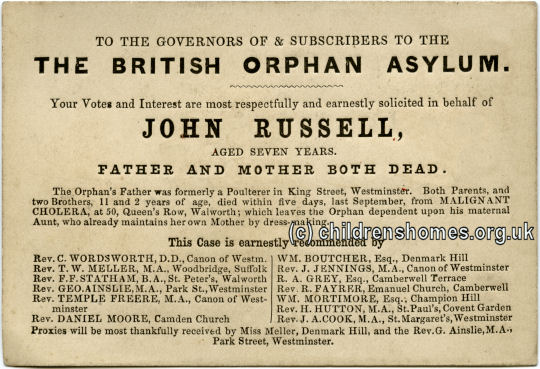
British Orphan Asylum petition card, c.1860s. © Peter Higginbotham
In 1834, the establishment moved to larger premises at Clapham Rise (later redesignated as 380 Clapham Road) and was renamed the British Orphan Asylum. At that date, the household consisted of a matron, master and governess, and 46 children (19 girls and 27 boys). In 1844, a new wing was added to the building at a cost of £1,400, increasing the home's capacity to over 100 children.
A widespread outbreak of cholera in 1854 led top a surge in the number of orphans seeking places at the home, placing a considerable strain on the charity's finances. At around the same time, donations to the institution declined with the onset of the Crimean War. An economy drive was launched, together with a reduction in the numbers of admissions being permitted. A respite came when a long-standing donor, Mr. George Moore, offered to give 100 guineas to the institution, provided nine other persons could be found to do the same within three months — an appeal that was promptly responded to.
In 1863, with the capacity of the Clapham premises proving too small for the then 110 inmates, the orphanage relocated to Slough in Buckinghamshire. The remaining thirty years of the Clapham building's lease was then sold for £2,500 to the British Home for Incurables.
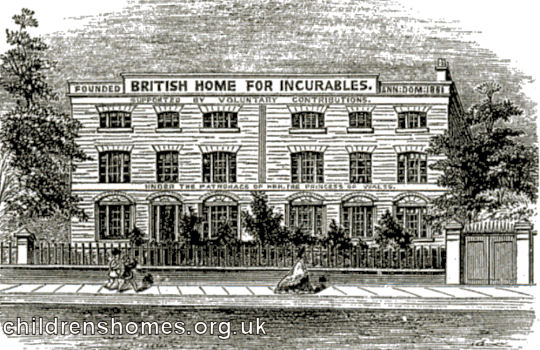
380 Clapham Road, c.1864. © Peter Higginbotham
The move to Slough was made possible by a donation of £14,000 to the charity from Major Edward Mackenzie of Fawley Court, Henley. The new home, which stood on Mackenzie Street (also named after the Major) had previously been the town's Royal Hotel, closed in 1852. The property, which had six acres of grounds, could house more than 200 children. The establishment was officially opened on June 24th, 1863, in the presence of Prince Edward and Princess Alexandra who each planted a sequoia tree.
The location of the home is shown on the 1899 map below.
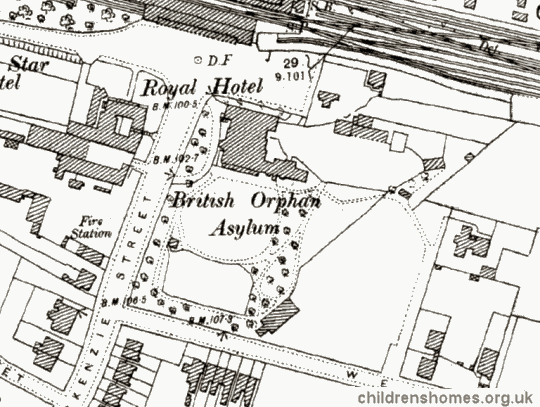
British Orphan Asylum site, Slough, c.1899.
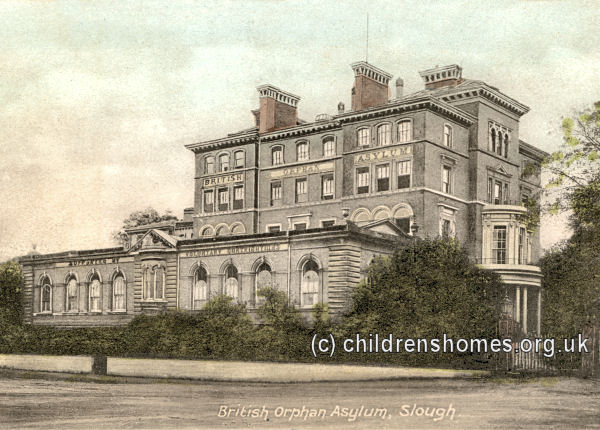
British Orphan Asylum from the north-west, Slough, c.1913. © Peter Higginbotham
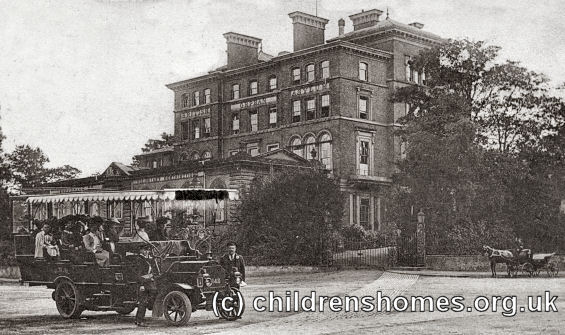
British Orphan Asylum from the north-west, Slough, c.1907. © Peter Higginbotham
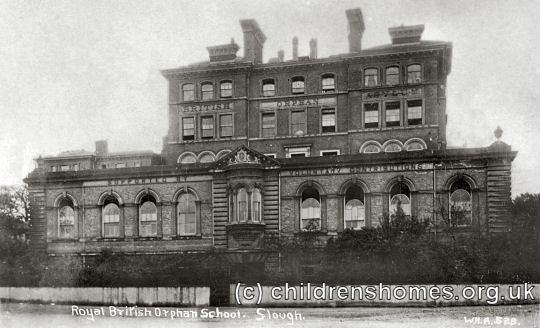
British Orphan Asylum from the north, Slough, c.1905. © Peter Higginbotham
The buildings were later considerably enlarged. A swimming bath was added in 1881, and a separate school for young boys was built by Algernon Gilliat of Stoke Poges in 1884.
An 1890 directory gave the charity's details as follows:
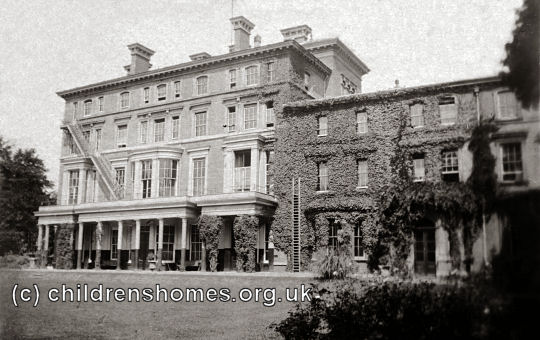
British Orphan Asylum from the south-east, Slough, c.1908. © Peter Higginbotham
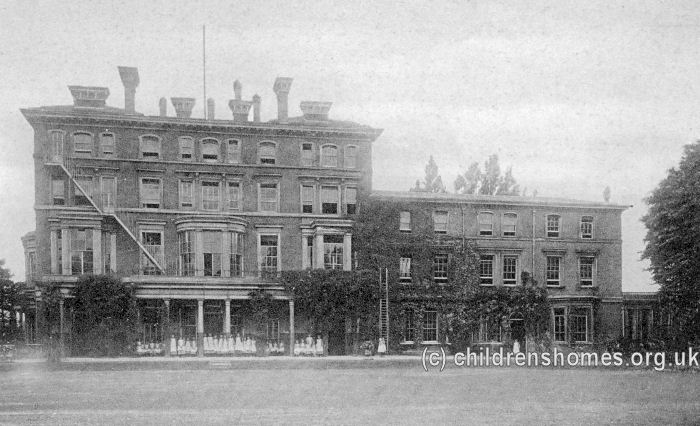
British Orphan Asylum from the south-east, Slough, c.1968. © Peter Higginbotham
Being entirely dependent on voluntary contributions, the Orphan Asylum always struggled to stay afloat. In 1920, its financial straits finally led to its closure and amalgamation with the London Orphan School in Watford. The institution moved to Cobham in Surrey in 1946, where it still exists today as Reed's School.
In 1921, the Slough premises became home to the Licensed Victuallers' School until it was demolished in 1938 to be replaced by a new building on another part of the estate.
Records
Note: many repositories impose a closure period of up to 100 years for records identifying individuals. Before travelling a long distance, always check that the records you want to consult will be available.
- Surrey History Centre, 130 Goldsworth Road, Woking, Surrey GU21 6ND. Has a few odd items but admission records etc. appear not to have survived.
Census
Bibliography
- Higginbotham, Peter Children's Homes: A History of Institutional Care for Britain s Young (2017, Pen & Sword)
Links
- None identified at present.
Except where indicated, this page () © Peter Higginbotham. Contents may not be reproduced without permission.


